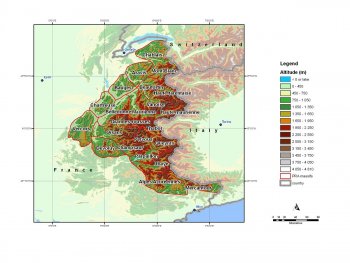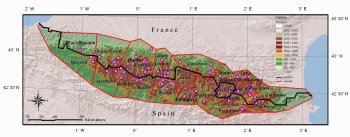The SAFRAN-Crocus-MEPRA
The SAFRAN/Crocus/MEPRA chain for avalanche hazard forecast:
The snowpack characteristics are very variable for a given mountain range, elevation and exposition. That is why the avalanche hazard forecasting is based on a snow and weather observations network as dense as possible. However, these observations are quite scarce mainly because of their cost (most of them are manual). Hence, some mountain ranges without any ski resort have very few observations.
Progress in snow research and numerical simulation make it possible to simulate the main features of the snowpack and the corresponding avalanche activity. Based on three individual models (SAFRAN, Crocus, and MEPRA) CEN has developed the SCM chain of models [Durand et al. 1999]. The only inputs to this chain are daily meteorological observations, outputs of numerical meteorological models and precipitation climatology. No snowpack information is currently entered into the system. The main assumption of this system lies in the spatial homogeneity of the massifs involved (especially for precipitation) which implies a corresponding working scale and excludes representing all the local effects such as those related to accumulation and erosion by the wind. The typical surface area for each massif is about 400 km2. The main output of the model chain is an average snowpack, described by its simulated stratigraphic profile and the corresponding avalanche risks, with a 300 m vertical resolution (from 900 to 3600 m asl) and for 6 aspects (N, E, SE, S, SO, O) and 3 slopes (0, 20°, 40°) of 23 massifs in the Alps, 15 in the Pyrenees and 2 in Corsica. Since the winter of 1992-93, this set of models has been used operationally by French Alps avalanche forecasters and since 1995-96 in the Pyrenees. At the same time it has been developed, improved and evaluated through interactions with the different users and by comparison with different sets of human observations. The SCM chain starts on the first of August without any snow on the ground and runs all year long without any re-initialisation. The snow cover is thus only due to the hourly meteorological forcing provided by Safran for its creation, evolution and vanishing.
The currently operational chain: SAFRAN - SURFEX/ISBA-Crocus - MEPRA (S2M)
The Crocus model in the operational chain of numerical simulation SAFRAN/Crocus/MEPRA (SCM) was replaced in 2014 by SURFEX/ISBA-Crocus (see SURFEX. The better representation of heat exchange in the soil-snow interface allows in some situations early in the season to improve the simulated stratigraphy of the snowpack. It also allowed extending of this chain to smaller elevation areas (Vosges, Jura and Massif Central), where sometimes intermittent snowpack is more influenced by the energy flux between the ground and snow [Lafaysse et al., 2013]. For the same reasons, the application of SURFEX/ISBA-Crocus in lowland areas also becomes possible and could allow for example a real-time estimation of the water equivalent of the snowpack (hydrological issues, roof strength of buildings). Using SURFEX/ISBA-Crocus is also being studied for an emerging system of avalanche warning system in Norway. The integration of Crocus in SURFEX also opens towards new prospects such as the assimilation data ground (snow depth, water equivalent of snow) or remote sensing ( passive and active microwave, visible/near infrared, thermal infrared). Since 2015, the S2M model chain has been run experimentally using input from ensemble meteorological prediction systems [Vernay et al., 2015].
References:
Durand, Y.; Giraud, G.; Brun, E.; Mérindol, L. & Martin, E.: A computer-based system simulating snowpack structures as a tool for regional avalanche forecasting. J. Glaciol., 1999, 45, 469-484
Brun, E.; David, P.; Sudul, M. & Brunot, G.: A numerical model to simulate snow-cover stratigraphy for operational avalanche forecasting. J. Glaciol., 1992, 38, 13 - 22
Giraud, G.: MEPRA: an expert system for avalanche risk forecasting. Proceedings of the International snow science workshop, 4-8 oct 1992, Breckenridge, Colorado, USA, 1992, 97-106
Lafaysse, M., S. Morin, C. Coléou, M. Vernay, D. Serça, F. Besson, J.-M. Willemet, G. Giraud and Y. Durand, Towards a new chain of models for avalanche hazard forecasting in French mountain ranges, including low altitude mountains, Proceedings of the International Snow Science Workshop Grenoble - Chamonix Mont-Blanc - 2013, 7-11 October, Grenoble, France, 162-166, 2013.
Vernay, M., M. Lafaysse, L. Mérindol, G. Giraud and S. Morin, Ensemble forecasting of snowpack conditions and avalanche hazard, Cold Reg. Sci. Technol., 120, 251-262, doi:10.1016/j.coldregions.2015.04.010, 2015.
Vionnet, V.; Brun, E.; Morin, S.; Boone, A.; Martin, E.; Faroux, S.; Moigne, P. L. & Willemet, J.-M.:The detailed snowpack scheme Crocus and its implementation in SURFEX v7.2, Geosci. Model. Dev., 2012, 5, 773-791





